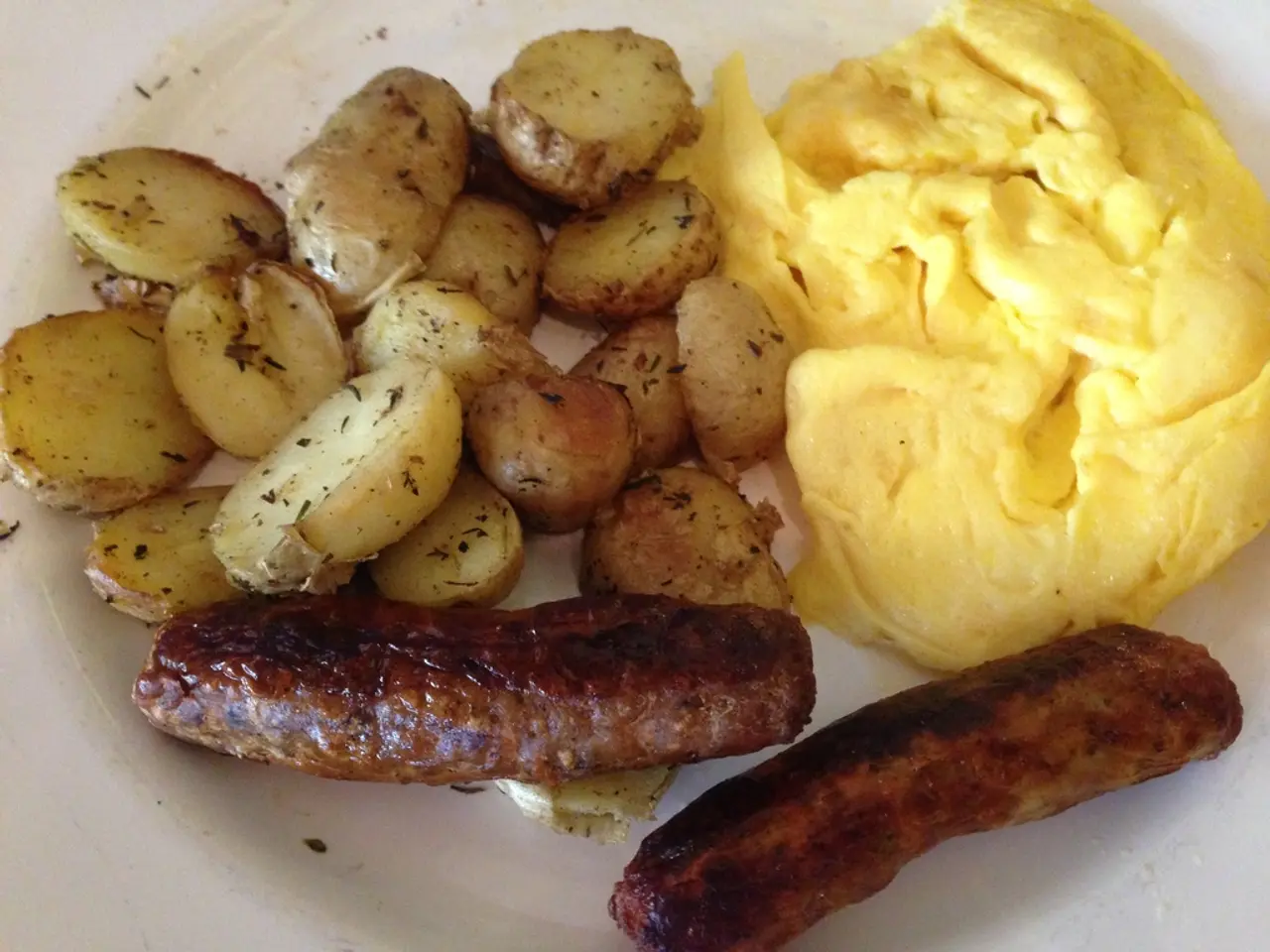Large Dog Diet: Choosing the Ideal Homemade Food Recipes for Your Canine Companion
Feeding your large dog a homemade diet can offer numerous benefits, but it's crucial to ensure the meals are balanced and nutritious. Here's what you need to know about homemade dog food for large breeds.
Nutrition and Control
Preparing homemade dog food allows you to control the ingredients, avoiding artificial preservatives, fillers, and low-quality components commonly found in some commercial kibble. By tailoring meals to individual dietary needs, you can ensure your dog receives the right nutrition for their specific health concerns [1][2].
Freshness and Nutrient Retention
Fresh ingredients retain more vitamins, minerals, and antioxidants compared to processed commercial foods. This can contribute to better overall health for your dog [1][2].
Customization and Quality
Homemade meals can be customized for specific health concerns, such as low-fat diets for overweight dogs or joint-supporting supplements for seniors. Using high-quality, organic, human-grade ingredients increases safety and nutritional value [1][3].
Challenges
While homemade diets offer many benefits, they require careful recipe formulation to avoid nutrient deficiencies or imbalances. Some commercial foods include additives like fish oil and probiotics that may offer extra health benefits [2][3].
Cost and Convenience
Homemade food can be less expensive than premium commercial brands but may take more time and effort to prepare and store properly. Meal delivery services or dehydrated fresh foods offer alternatives that combine quality with convenience [2][3].
Transitioning to Homemade Food
When transitioning a dog to homemade food, it's best to do so gradually over 5-7 days to avoid digestive issues. Depending on the recipe, supplements like calcium, omega-3, or multivitamins may be needed to ensure balanced nutrition [4].
Important Considerations
It's important to avoid certain foods like onions, garlic, grapes, chocolate, avocado, raw potatoes, macadamia nuts, and processed foods, as they can be toxic to dogs. Large dogs need 2-3% of their body weight in food daily [4].
Recipes for Large Breeds
Beef & Sweet Potato Power Meal
Ingredients: - 2 lbs lean ground beef - 1 large sweet potato - 1 cup peas - 1 cup brown rice - 1 tbsp fish oil
Instructions: 1. Cook the brown rice according to package instructions. 2. Bake the sweet potato until soft. 3. Brown the ground beef and add peas. 4. Combine cooked rice, sweet potato, and beef. 5. Stir in fish oil.
Salmon & Brown Rice Omega Boost
Ingredients: - 2 lbs cooked, boneless salmon - 1.5 cups cooked brown rice - 1 cup steamed carrots - 1/2 cup chopped green beans - 1 tbsp flaxseed oil
Instructions: 1. Cook the brown rice and steam the carrots and green beans. 2. Combine cooked rice, salmon, carrots, and green beans. 3. Stir in flaxseed oil.
Consult a Veterinarian
It's recommended to consult a veterinarian to ensure the homemade diet meets your dog's unique needs. A well-balanced homemade diet can lead to improved health, better digestion, and more energy [4].
Starting Small
A helpful tip is to start with small batches and observe how your dog reacts to the new diet before fully transitioning [5].
Chicken & Pumpkin Digestive Booster
Ingredients: - 2 lbs boneless, skinless chicken thighs - 1 cup pumpkin puree - 1 cup quinoa - 1/2 cup spinach - 1 tbsp olive oil
Instructions: 1. Cook the chicken and quinoa. 2. Sauté the spinach. 3. Combine cooked chicken, quinoa, spinach, and pumpkin puree. 4. Stir in olive oil.
Let the meal cool before serving.
In summary, homemade food can be healthier for large dogs by providing fresher, more natural, and customizable nutrition, but requires thoughtful preparation and expert guidance to ensure dietary completeness [1][2][3]. Always consult a veterinarian to ensure the homemade diet meets your dog's unique needs.
[1] Fascetti, A. J., & Thatcher, C. D. (2012). Nutritional management of dogs and cats with cancer. Veterinary Clinics of North America: Small Animal Practice, 42(6), 1175–1201.
[2] Delaney, S. J., & O'Neill, D. G. (2012). Nutritional management of the obese dog and cat. Veterinary Clinics of North America: Small Animal Practice, 42(6), 1203–1216.
[3] Slatter, D. M., & Delaney, S. J. (2012). Nutritional management of the geriatric dog and cat. Veterinary Clinics of North America: Small Animal Practice, 42(6), 1217–1229.
[4] Freeman, L. M., & Erb, H. N. (2015). Nutritional management of the dog and cat. In J. F. Bonagura & D. G. Hopkins (Eds.), Current Veterinary Therapy XI: Small Animal Practice (pp. 401–428). Elsevier Inc.
[5] Vadeboncoeur, J. (2012). Dietary management of the dog and cat. In J. F. Bonagura & D. G. Hopkins (Eds.), Current Veterinary Therapy XI: Small Animal Practice (pp. 395–400). Elsevier Inc.
Restaurating your pet's lifestyle at home might involve more than just their meals, as home-and-garden improvements can provide a comfortable and calm environment for them. For instance, establishing a pet-friendly garden can offer your pets a safe and enjoyable outdoor space to play and relax [6].
With a homemade diet specifically tailored for large breeds, you can focus not only on the nutritional needs of your dog but also consider supplements beneficial for their pets, such as joint-supporting supplements for senior dogs or probiotics for improved digestion [1][2].




